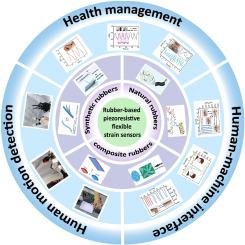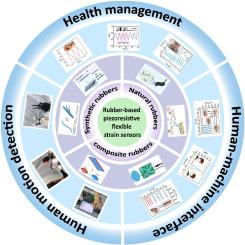Advances in rubber-based piezoresistive flexible strain sensors
IF 9.7
2区 材料科学
Q1 MATERIALS SCIENCE, MULTIDISCIPLINARY
引用次数: 0
Abstract
With the rapid development of science and technology, flexible strain sensors have attracted widespread attention in various fields such as electronic skin and healthcare due to their excellent sensitivity. Among them, rubber materials are considered ideal for stretchable electronic devices due to their flexibility. This paper primarily introduces rubber-based flexible strain sensors, outlining their sensing mechanisms and key performance parameters. This paper innovatively selects rubber materials with different characteristics as flexible substrates. Through systematic experimental comparisons and theoretical analyses, it deeply explores the influence and advantages of different rubber substrates on key performance indicators such as the sensitivity, working range, and long-term stability of piezoresistive flexible strain sensors, and proposes targeted optimization strategies. Rubber is mainly categorized into natural rubber and synthetic rubber. Natural rubber, owing to its good elasticity, low cost, and good biocompatibility, has promoted the green development of electronic devices. For instance, the NR/N-BP/NR sandwich strain sensor exhibits ultra-high sensitivity (GF = 2280) and a wide operating range of up to 500 %. Synthetic rubbers, including silicone rubber, nitrile butadiene rubber, and styrene butadiene rubber, have demonstrated great potential in the fabrication of flexible strain sensors due to their resistance to chemicals, heat, and wear. For example, the bilayer strain sensor fabricated from CB and PDMS demonstrates long-term stability over 10,000 loading-unloading cycle tests. The specific applications of these sensors in fields such as human motion detection, health management, and human-machine interfaces are also reviewed. Finally, the challenges faced by rubber-based flexible strain sensors are discussed, and prospects for enhancing their sensing performance and durability under extreme environmental conditions are anticipated.


橡胶基压阻式柔性应变传感器的研究进展
随着科学技术的飞速发展,柔性应变传感器以其优异的灵敏度在电子皮肤、医疗保健等各个领域受到了广泛的关注。其中,橡胶材料因其柔韧性被认为是可拉伸电子器件的理想材料。本文主要介绍了基于橡胶的柔性应变传感器,概述了其传感机理和关键性能参数。本文创新性地选用了不同特性的橡胶材料作为柔性基材。通过系统的实验比较和理论分析,深入探讨不同橡胶基材对压阻式柔性应变传感器灵敏度、工作范围、长期稳定性等关键性能指标的影响和优势,并提出有针对性的优化策略。橡胶主要分为天然橡胶和合成橡胶。天然橡胶因其弹性好、成本低、生物相容性好等优点,促进了电子器件的绿色发展。例如,NR/N-BP/NR三明治应变传感器具有超高灵敏度(GF = 2280)和高达500%的宽工作范围。合成橡胶,包括硅橡胶、丁腈橡胶和苯乙烯丁二烯橡胶,由于其耐化学品、耐热性和耐磨性,在制造柔性应变传感器方面显示出巨大的潜力。例如,由CB和PDMS制成的双层应变传感器在10,000次加载-卸载循环测试中显示出长期稳定性。综述了这些传感器在人体运动检测、健康管理和人机界面等领域的具体应用。最后,讨论了橡胶基柔性应变传感器面临的挑战,并展望了其在极端环境条件下提高传感性能和耐久性的前景。
本文章由计算机程序翻译,如有差异,请以英文原文为准。
求助全文
约1分钟内获得全文
求助全文
来源期刊

Materials Today Physics
Materials Science-General Materials Science
CiteScore
14.00
自引率
7.80%
发文量
284
审稿时长
15 days
期刊介绍:
Materials Today Physics is a multi-disciplinary journal focused on the physics of materials, encompassing both the physical properties and materials synthesis. Operating at the interface of physics and materials science, this journal covers one of the largest and most dynamic fields within physical science. The forefront research in materials physics is driving advancements in new materials, uncovering new physics, and fostering novel applications at an unprecedented pace.
 求助内容:
求助内容: 应助结果提醒方式:
应助结果提醒方式:


